Yamaha RX-V592, RX-V692 User Manual
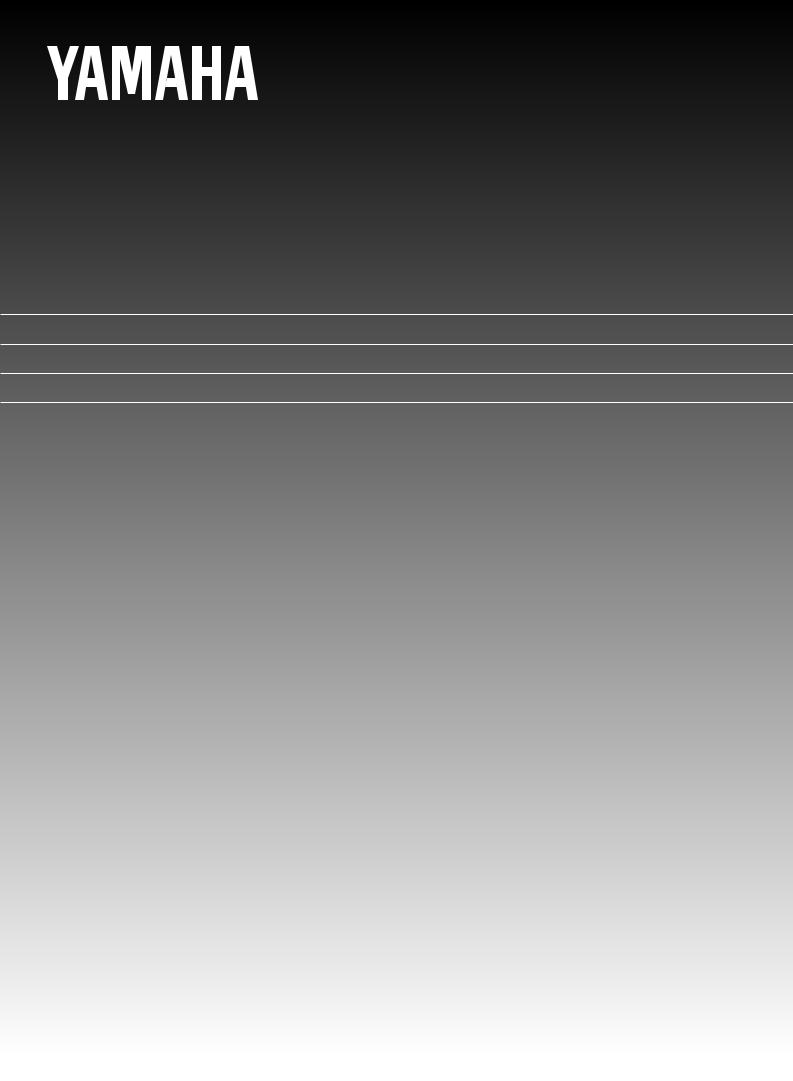
RX-V692
RX-V592
Natural Sound AV Receiver
Récepteur audiovisuel “Son Naturel”
Receptor AV de Sonido Natural
Thank you for selecting this YAMAHA AV receiver.
Nous vous remercions d’avoir porté votre choix sur ce récepteur audiovisuel YAMAHA.
Muchas gracias por haber adquirido este receptor AV YAMAHA.
OWNER’S MANUAL MODE D’EMPLOI MANUAL DE INSTRUCCIONES
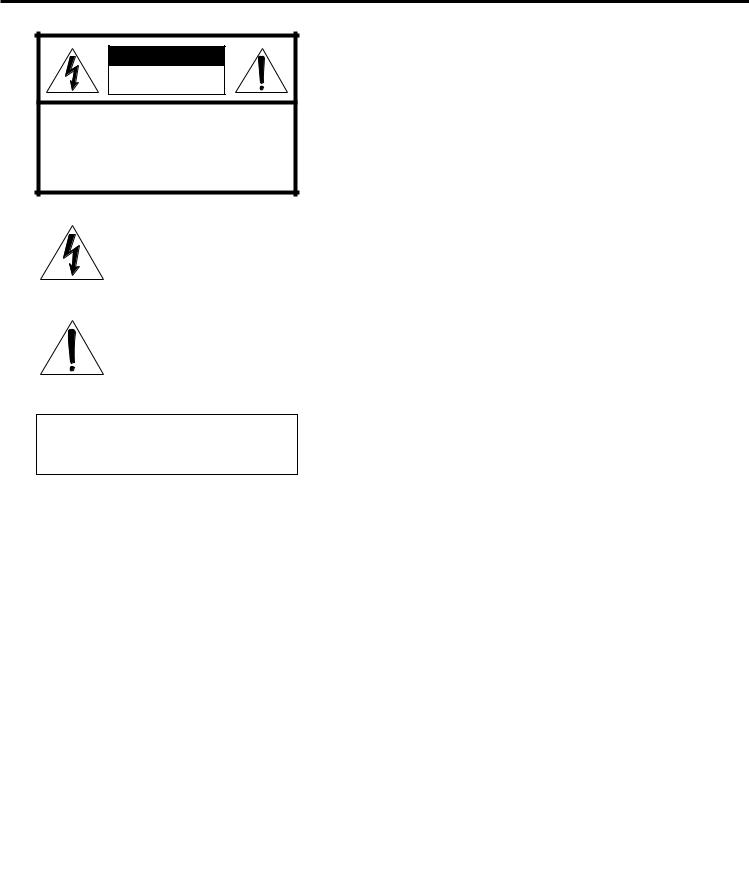
SAFETY INSTRUCTIONS
CAUTION
RISK OF ELECTRIC SHOCK
DO NOT OPEN
CAUTION: TO REDUCE THE RISK OF
ELECTRIC SHOCK, DO NOT REMOVE
COVER (OR BACK). NO USER-SERVICEABLE
PARTS INSIDE. REFER SERVICING TO
QUALIFIED SERVICE PERSONNEL.
• Explanation of Graphical Symbols
The lightning flash with arrowhead symbol, within an equilateral triangle, is intended to alert you to the presence of uninsulated “dangerous voltage” within the product’s enclosure that may be of sufficient magnitude to constitute a risk of electric shock to persons.
The exclamation point within an equilateral triangle is intended to alert you to the presence of important operating and maintenance (servicing) instructions in the literature accompanying the appliance.
WARNING
TO REDUCE THE RISK OF FIRE OR
ELECTRIC SHOCK, DO NOT EXPOSE THIS
UNIT TO RAIN OR MOISTURE.
1Read Instructions – All the safety and operating instructions should be read before the unit is operated.
2Retain Instructions – The safety and operating instructions should be retained for future reference.
3Heed Warnings – All warnings on the unit and in the operating instructions should be adhered to.
4Follow Instructions – All operating and other instructions should be followed.
5Water and Moisture – The unit should not be used near water – for example, near a bathtub, washbowl, kitchen sink, laundry tub, in a wet basement, or near a swimming pool, etc.
6Carts and Stands – The unit should be used only with a cart or stand that is recommended by the manufacturer.
6A A unit and cart combination should be moved with care. Quick stops, excessive force, and uneven surfaces may cause the unit and
cart combination to overturn.
7Wall or Ceiling Mounting – The unit should be mounted to a wall or ceiling only as recommended by the manufacturer.
8Ventilation – The unit should be situated so that its location or position does not interfere with its proper ventilation. For example, the unit should not be situated on a bed, sofa, rug, or similar surface, that may block the ventilation openings; or placed in a built-in installation, such as a bookcase or cabinet that may impede the flow of air through the ventilation openings.
9Heat – The unit should be situated away from heat sources such as radiators, stoves, or other appliances that produce heat.
10Power Sources – The unit should be connected to a power supply only of the type described in the operating instructions or as marked on the unit.
11Power-Cord Protection – Power-supply cords should be routed so that they are not likely to be walked on or pinched by items placed upon or against them, paying particular attention to cords at plugs, convenience receptacles, and the point where they exit from the unit.
12Cleaning – The unit should be cleaned only as recommended by the manufacturer.
13Nonuse Periods – The power cord of the unit should be unplugged from the outlet when left unused for a long period of time.
14Object and Liquid Entry – Care should be taken so that objects do not fall into and liquids are not spilled into the inside of the unit.
15Damage Requiring Service – The unit should be serviced by qualified service personnel when:
A.The power-supply cord or the plug has been damaged; or
B.Objects have fallen, or liquid has been spilled into the unit; or
C.The unit has been exposed to rain; or
D.The unit does not appear to operate normally or exhibits a marked change in performance; or
E.The unit has been dropped, or the cabinet damaged.
16Servicing – The user should not attempt to service the unit beyond those means described in the operating instructions. All other servicing should be referred to qualified service personnel.
17Power Lines – An outdoor antenna should be located away from power lines.
18Grounding or Polarization – Precautions should be taken so that the grounding or polarization is not defeated.

19For US customers only:
Outdoor Antenna Grounding – If an outside antenna is connected to this unit, be sure the antenna system is grounded so as to provide some protection against voltage surges and built-up static charges. Article 810 of the National Electrical Code, ANSI/NFPA 70, provides information with regard to proper grounding of the mast and supporting structure, grounding of the lead-in wire to an antenna discharge unit, size of grounding conductors, location of antenna discharge unit, connection to grounding electrodes, and requirements for the grounding electrode.
Note to CATV system installer:
This reminder is provided to call the CATV system installer’s attention to Article 820-40 of the NEC that provides guidelines for proper grounding and, in particular, specifies that the cable ground shall be connected to the grounding system of the building, as close to the point of cable entry as practical.
EXAMPLE OF ANTENNA GROUNDING
MAST |
ANTENNA |
|
LEAD IN |
|
WIRE |
GROUND |
|
CLAMP |
|
|
ANTENNA |
|
DISCHARGE UNIT |
|
(NEC SECTION 810–20) |
ELECTRIC |
|
SERVICE |
|
EQUIPMENT |
GROUNDING CONDUCTORS |
|
|
|
(NEC SECTION 810–21) |
|
GROUND CLAMPS |
|
POWER SERVICE GROUNDING |
|
ELECTRODE SYSTEM |
|
(NEC ART 250. PART H) |
NEC – NATIONAL ELECTRICAL CODE |
|
SPECIAL NOTES FOR FCC COMPOSITE DEVICE (for US customers only)
This device is a composite system. The digital device component may not cause harmful interference.
FCC INFORMATION (for US customers only)
1. IMPORTANT NOTICE : DO NOT MODIFY THIS UNIT! |
Compliance with FCC regulations does not guarantee that |
|
This product, when installed as indicated in the |
interference will not occur in all installations. If this product |
|
instructions contained in this manual, meets FCC |
is found to be the source of interference, which can be |
|
requirements. Modifications not expressly approved by |
determined by turning the unit “OFF” and “ON”, please try |
|
Yamaha may void your authority, granted by the FCC, to |
to eliminate the problem by using one of the following |
|
use the product. |
measures: |
|
2. IMPORTANT : When connecting this product to |
Relocate either this product or the device that is being |
|
accessories and/or another product use only high quality |
affected by the interference. |
|
shielded cables. Cable/s supplied with this product |
Utilize power outlets that are on different branch (circuit |
|
MUST be used. Follow all installation instructions. |
||
breaker or fuse) circuits or install AC line filter/s. |
||
Failure to follow instructions could void your FCC |
||
|
||
authorization to use this product in the USA. |
In the case of radio or TV interference, relocate/reorient the |
|
3. NOTE : This product has been tested and found to |
antenna. If the antenna lead-in is 300 ohm ribbon lead, |
|
comply with the requirements listed in FCC Regulations, |
change the lead-in to coaxial type cable. |
|
Part 15 for Class “B” digital devices. Compliance with |
If these corrective measures do not produce satisfactory |
|
these requirements provides a reasonable level of |
||
results, please contact the local retailer authorized to |
||
assurance that your use of this product in a residential |
||
distribute this type of product. If you can not locate the |
||
environment will not result in harmful interference with |
||
appropriate retailer, please contact Yamaha Electronics |
||
other electronic devices. |
||
Corp., U.S.A. 6660 Orangethorpe Ave, Buena Park, CA |
||
This equipment generates/uses radio frequencies and, if |
||
90620. |
||
not installed and used according to the instructions |
The above statements apply ONLY to those products |
|
found in the users manual, may cause interference |
||
distributed by Yamaha Corporation of America or its |
||
harmful to the operation of other electronic devices. |
||
subsidiaries. |
||
|
We Want You Listening For A Lifetime (for US customers only)
YAMAHA and the Electronic Industries Association’s |
Since hearing damage from loud sounds is often |
Consumer Electronics Group want you to get the most out of |
undetectable until it is too late, YAMAHA and the |
your equipment by playing it at a safe level. One that lets the |
Electronic Industries Association’s Consumer |
sound come through loud and clear without annoying blaring |
Electronics Group recommend you to avoid |
or distortion – and, most importantly, without affecting your |
prolonged exposure from excessive volume levels. |
sensitive hearing. |
|
English
1
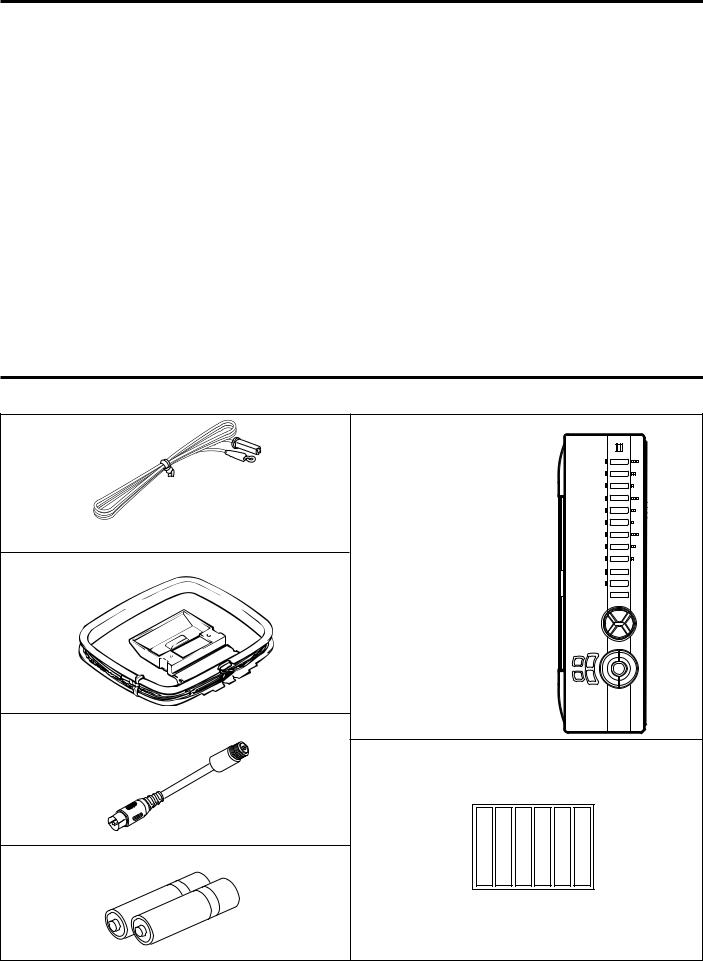
CONTENTS
Safety Instructions ............... |
Inside the Front Cover |
|
Supplied Accessories ...................................... |
|
2 |
Features .......................................................... |
|
3 |
Caution ............................................................ |
|
4 |
Notes about the Remote Control Transmitter |
|
|
........................................................................ |
|
5 |
Profile of This Unit ........................................... |
|
6 |
Speaker Setup ................................................ |
|
7 |
Connections .................................................... |
|
8 |
Controls and Their Functions ........................ |
16 |
|
Speaker Balance Adjustment ........................ |
20 |
Basic Operations ........................................... |
23 |
Tuning Operations ......................................... |
26 |
Preset Tuning ................................................ |
27 |
Using Digital Sound Field Processor (DSP) |
|
...................................................................... |
30 |
Setting the SLEEP Timer .............................. |
35 |
Remote Control Transmitter .......................... |
36 |
Troubleshooting ............................................. |
46 |
Specifications ................................................ |
47 |
SUPPLIED ACCESSORIES
After unpacking, check that the following parts are included.
Indoor FM Antenna |
Remote Control Transmitter |
AM Loop Antenna
Antenna adapter (U.S.A. and Canada models only)
User function stickers
Batteries (size AA, R6, UM-3)
2
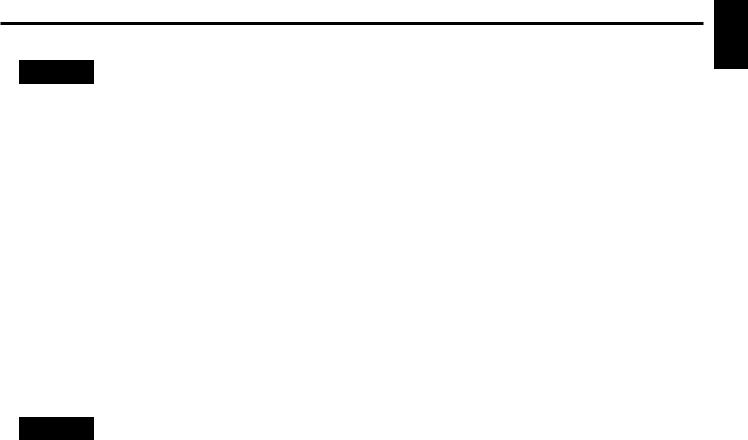
FEATURES
● 5 Speaker Configuration
RX-V692
<U.S.A. and Canada models>
Main: 80W + 80W (8Ω ) RMS Output
Power, 0.04% THD, 20–20,000 Hz Center: 80W (8Ω ) RMS Output Power,
0.07% THD, 20–20,000 Hz Rear: 40W + 40W (8Ω ) RMS Output
Power, 0.3% THD, 1 kHz
<Australia, Singapore and General models>
Main: 75W + 75W (8Ω ) RMS Output
Power, 0.04% THD, 20–20,000 Hz Center: 75W (8Ω ) RMS Output Power,
0.07% THD, 20–20,000 Hz Rear: 40W + 40W (8Ω ) RMS Output
Power, 0.3% THD, 1 kHz
RX-V592
<U.S.A. and Canada models>
Main: 75W + 75W (8Ω ) RMS Output
Power, 0.04% THD, 20–20,000 Hz Center: 75W (8Ω ) RMS Output Power,
0.07% THD, 20–20,000 Hz Rear: 35W + 35W (8Ω ) RMS Output
Power, 0.3% THD, 1 kHz
<Australia, Singapore and General models>
Main: 70W + 70W (8Ω ) RMS Output
Power, 0.04% THD, 20–20,000 Hz Center: 70W (8Ω ) RMS Output Power,
0.07% THD, 20–20,000 Hz Rear: 35W + 35W (8Ω ) RMS Output
Power, 0.3% THD, 1 kHz
●Digital Sound Field Processor
●Dolby Pro Logic Surround Decoder
●Theater-like Sound Experience by the Combination of Dolby Pro Logic and YAMAHA DSP Technology (CINEMA DSP)
●Automatic Input Balance Control for Dolby Pro Logic Surround
●Test Tone Generator for Easier Speaker Balance Adjustment
●3 Center Channel Modes (NORMAL/WIDE/PHANTOM)
●BASS EXTENSION Switch for Reinforcing Bass Response
●40-Station Random Access Preset Tuning
●Automatic Preset Tuning
●Preset Station Shifting Capability (Preset Editing)
●IF Count Direct PLL Synthesizer Tuning System
●Video Signal Input/Output Capability
●6-Channel Discrete Input Terminals for Connecting with a Dolby Digital (AC-3) Decoder
●SLEEP Timer
●“Learning” Remote Control Transmitter
English
3
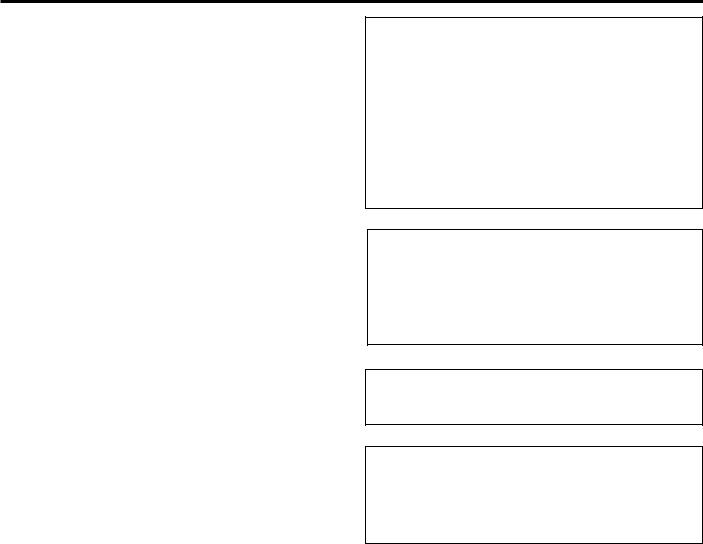
CAUTION : READ THIS BEFORE OPERATING YOUR UNIT.
1.To assure the finest performance, please read this manual carefully. Keep it in a safe place for future reference.
2.Install this unit in a cool, dry, clean place – away from windows, heat sources, sources of excessive vibration, dust, moisture and cold. Avoid sources of humming (transformers, motors). To prevent fire or electrical shock, do not expose the unit to rain or water.
3.Never open the cabinet. If something drops into the set, contact your dealer.
4.Do not use force on switches, controls or connection wires. When moving the unit, first disconnect the power plug and the wires connected to other equipment. Never pull the wires themselves.
5.The openings on the cabinet assure proper ventilation of the unit. If these openings are obstructed, the temperature inside the cabinet will rise rapidly. Therefore, avoid placing objects against these openings, and install the unit in wellventilated condition. Make sure to allow a space of at least 10 cm behind, 20 cm on the both sides and 30 cm above the top panel of the unit. Otherwise it may not only damage the unit, but also cause fire.
6.Always set the VOLUME control to “–∞ ” before starting the audio source play. Increase the volume gradually to an appropriate level after playback has been started.
7.Do not attempt to clean the unit with chemical solvents; this might damage the finish. Use a clean, dry cloth.
8.Be sure to read the “TROUBLESHOOTING” section regarding common operating errors before concluding that the unit is faulty.
9.When not planning to use this unit for long periods of time (ie., vacation, etc.), disconnect the AC power plug from the wall outlet.
10.To prevent lightning damage, disconnect the AC power plug and disconnect the antenna cable when there is an electrical storm.
11.Grounding or polarization – Precautions should be taken so that the grounding or polarization of an appliance is not defeated.
12.AC outlet
Do not connect audio equipment to the AC outlet on the rear panel if that equipment requires more power than the outlet is rated to provide.
13.Voltage Selector (General Model only)
The voltage selector on the rear panel of this unit must be set for your local main voltage BEFORE plugging into the AC main supply.
Voltages are 110/120/220/240 V AC, 50/60 Hz.
IMPORTANT
Please record the serial number of this unit in the space below.
Serial No.:
The serial number is located on the rear of the unit. Retain this Owner’s Manual in a safe place for future reference.
WARNING
TO REDUCE THE RISK OF FIRE OR ELECTRIC SHOCK, DO NOT EXPOSE THIS UNIT TO RAIN OR MOISTURE.
FOR CANADIAN CUSTOMERS
TO PREVENT ELECTRIC SHOCK, MATCH WIDE BLADE OF PLUG TO WIDE SLOT AND FULLY INSERT.
THIS CLASS B DIGITAL APPARATUS MEETS ALL REQUIREMENTS OF THE CANADIAN INTERFERENCECAUSING EQUIPMENT REGULATIONS.
The apparatus is not disconnected from the AC power source as long as it is connected to the wall outlet, even if the apparatus itself is turned off.
FREQUENCY STEP switch (General Model only)
Because the interstation frequency spacing differs in different areas, set the FREQUENCY STEP switch (located at the rear) according to the frequency spacing in your area. Before setting this switch, disconnect the AC power plug of this unit from the AC outlet.
4
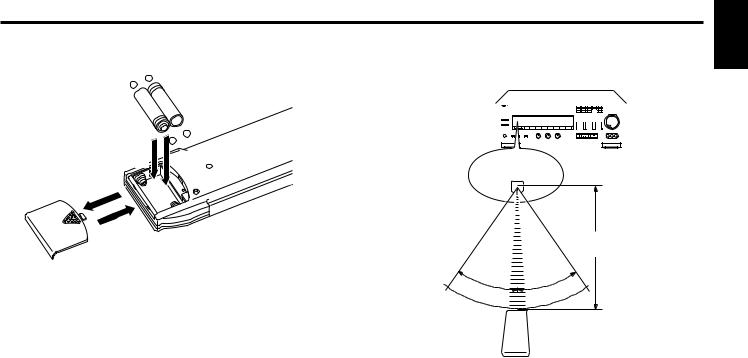
NOTES ABOUT THE REMOTE CONTROL TRANSMITTER
Battery installation |
|
|
|
|
|
|
|
Remote control transmitter operation range |
||||||||||||||||||
|
|
|
|
|
|
|
|
|
|
|
|
|
|
|
|
|
|
|
|
|
|
|
|
|
|
|
|
|
|
|
|
|
|
|
|
|
|
|
|
|
|
|
|
|
|
|
|
|
|
|
|
|
|
|
|
|
|
|
|
|
|
|
|
|
|
|
|
|
|
|
|
|
|
|
|
|
|
|
|
|
|
|
|
|
|
|
|
|
|
|
|
|
|
|
|
|
|
|
|
|
|
|
|
|
|
|
|
|
|
|
|
|
|
|
|
|
|
|
|
|
|
|
|
|
|
|
|
|
|
|
|
|
|
|
|
|
|
|
|
|
|
|
|
|
|
|
|
|
|
|
|
|
|
|
|
|
|
|
|
|
|
|
|
|
|
|
|
|
|
|
|
|
|
|
|
|
|
|
|
|
|
|
|
|
|
|
|
|
English
2
1
3
Battery replacement
If you find that the remote control transmitter must be used closer to the main unit, the batteries are weak. Replace both batteries with new ones.
Notes
●Use only AA, R6, UM-3 batteries for replacement.
●Be sure the polarities are correct. (See the illustration inside the battery compartment.)
●Remove the batteries if the remote control transmitter will not be used for an extended period of time.
●If batteries leak, dispose of them immediately. Avoid touching the leaked material or letting it come in contact with clothing, etc. Clean the battery compartment thoroughly before installing new batteries.
●After you change batteries, make sure to press the RESET button inside the battery compartment.
Remote control sensor
Within approximately 6 m (19.7 feet)
30° |
30° |
|
Notes
●There should be no large obstacles between the remote control transmitter and the main unit.
●If the remote control sensor is directly illuminated by strong lighting (especially an inverter type of fluorescent lamp etc.), it might cause the remote control transmitter not to work correctly. In this case, reposition the main unit to avoid direct lighting.
5

PROFILE OF THIS UNIT
You are the proud owner of a Yamaha stereo receiver –an extremely sophisticated audio component. The Digital Sound Field Processor (DSP) built into this unit takes advantage of Yamaha’s undisputed leadership in the field of digital audio processing to bring you a whole new world of listening experiences. Follow the instructions in this manual carefully when setting up your system, and this unit will sonically transform your room into a wide range of listening environments –movie theater, concert hall, and so on. In addition, you get incredible realism from sources encoded with Dolby Surround using the built-in Dolby Pro Logic Surround Decoder.
Please read this operation manual carefully and store it in a safe place for later reference.
Digital Sound Field Processing
What is it that makes live music so good? Today’s advanced sound reproduction technology lets you get extremely close to the sound of a live performance, but chances are you’ll still notice something missing: the acoustic environment of the live concert hall. Extensive research into the exact nature of the sonic reflections that create the ambience of a large hall has made it possible for Yamaha engineers to bring you this same sound in your own listening room, so you’ll feel all the sound of a live concert.
Furthermore, our technicians, armed with sophisticated measuring equipment, have even made it possible to capture the acoustics of a variety of venues such as an actual concert hall, theater, etc. to allow you to accurately recreate one of several actual live performance environments, all in your own home.
Dolby Pro Logic Surround
This unit employs a Dolby Pro Logic Surround decoder similar to professional Dolby Stereo decoders used in many movie theaters. By using the Dolby Pro Logic Surround decoder, you can experience the dramatic realism and impact of Dolby Surround movie theater sound in your own home. Dolby Pro Logic employs a four channel five speaker system. The Pro Logic Surround system divides the input signal into four levels: the left and right main channels, the center channel (used for dialog), and the rear surround sound channels (used for sound effects, background noise, and other ambient noises). The center channel allows listeners seated in even less-than-ideal positions to hear the dialog originating from the action on the screen while experiencing good stereo imaging.
Dolby Surround is encoded on the sound track of pre-recorded video tapes, laser discs, and some TV/cable broadcasts. When you play a source encoded with Dolby Surround on this unit, the Dolby Pro Logic Surround decoder decodes the signal and distributes the surround-sound effects.
This Dolby Pro Logic Surround Decoder employs a digital signal processing system. This system improves the stability of sound at each channel and minimizes crosstalk between channels, so that positioning of sounds around the room is more accurate compared with conventional analog signal processing systems.
In addition, this unit features a built-in automatic input balance control. This always assures you the best performance without manual adjustment.
Manufactured under license from Dolby Laboratories Licensing Corporation. “Dolby”, “AC-3”, “Pro Logic”, and the double-D symbol are trademarks of Dolby Laboratories Licensing Corporation.
Dolby Pro Logic Surround + DSP
Dolby Surround sound system shows its full ability in a large movie theater, because movie sounds are originally designed to be reproduced in a large movie theater using many speakers. It is difficult to create a sound environment similar to that of a movie theater in your listening room, because the room size, materials of inside walls, the number of speakers, etc. of your listening room is much different from those of a movie theater.
Yamaha DSP technology made it possible to present you with nearly the same sound experience as that of a large movie theater in your listening room by compensating for lack of presence and dynamics in your listening room with its original digital sound fields combined with Dolby Surround sound field.
The combination of Dolby Pro Logic Surround and DSP is used on the sound field program “  PRO LOGIC ENHANCED”.
PRO LOGIC ENHANCED”.
RX-V692 only
This combination is used on sound field programs “  PRO LOGIC ENHANCED”, “70 mm MOVIE THEATER” and “TV SPORTS”.
PRO LOGIC ENHANCED”, “70 mm MOVIE THEATER” and “TV SPORTS”.
CINEMA DSP
The YAMAHA “CINEMA DSP” logo indicates these programs are created by the combination of Dolby Pro Logic and YAMAHA DSP technology.
6
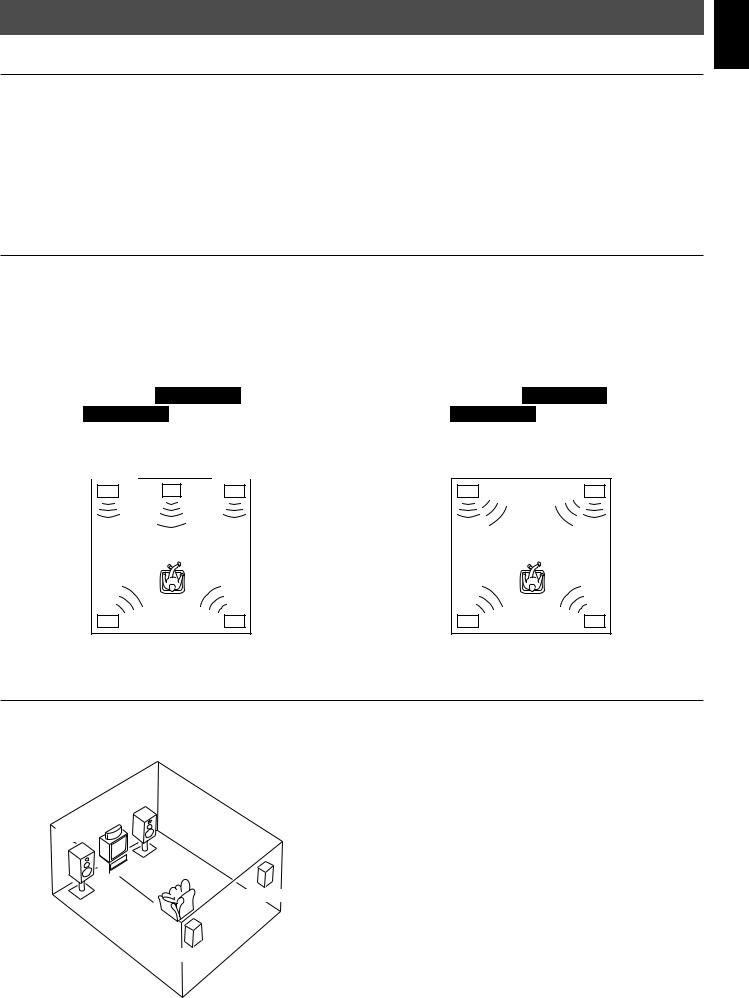
SPEAKER SETUP
SPEAKERS TO BE USED
This unit is designed to provide the best sound-field quality with a 5 speaker configuration. The most effective speakers to use with this unit are main speakers, rear speakers and a center speaker. You may omit the center speaker. (Refer to the “4-Speaker Configuration” shown below.)
The main speakers are used for the main source sound plus the effect sounds. They will probably be the speakers from your present stereo system. The rear speakers are used for the effect and surround sounds, and the center speaker is for the center sounds (dialog etc.) within programs encoded with Dolby Surround. The center speaker needs to be equal in power to the main speakers, although the rear speakers should not be equal. However, all the speakers should have high enough power handling to accept the maximum output of this unit.
SPEAKER CONFIGURATION
5-Speaker Configuration
This configuration is the most effective and recommended one. In this configuration, the center speaker is necessary as well as the rear speakers. If one of the programs shown below is selected, conversations will be output from the center speaker and the ambience will be excellent.
•
 PRO LOGIC
PRO LOGIC
•
 PRO LOGIC ENHANCED
PRO LOGIC ENHANCED
•70 mm MOVIE THEATER RX-V692 only
•TV SPORTS RX-V692 only
Note: Set the center channel mode to the “NORMAL” or “WIDE” position. (For details, refer to page 21.)
FrontMain L Center MaiFrontRR
Dialogue
4-Speaker Configuration
The center speaker is not used in this configuration. If one of the programs shown below is selected, the center sound is output from the left and the right main speakers. However, the sound effect of other programs can be the same as that of the 5-speaker configuration.
•
 PRO LOGIC
PRO LOGIC
•
 PRO LOGIC ENHANCED
PRO LOGIC ENHANCED
•70 mm MOVIE THEATER RX-V692 only
•TV SPORTS RX-V692 only
Note: Be sure to set the center channel mode to the “PHANTOM” position. (For details, refer to page 21.)
FrontMain L |
|
MaiFrontRR |
Dialogue
Surround sound |
Surround sound |
||
Rear L |
Rear R |
Rear L |
Rear R |
SPEAKER PLACEMENT
The recommended speaker configuration, the 5-speaker configuration, will require two speaker pairs: main speakers (your normal stereo speakers), and rear speakers, plus a center speaker. When you place these speakers, refer to the following.
English
MaiFrontRR
Center
MaiFrontLL
 TV set
TV set
Rear R
Rear L
Main: In normal position. (The position of your present stereo speaker system.)
Rear: Behind your listening position, facing slightly inward. Nearly six feet (approx. 1.8 m) up from the floor.
Center: Precisely between the main speakers. (To avoid interference with TV sets, use a magnetically shielded speaker.)
7
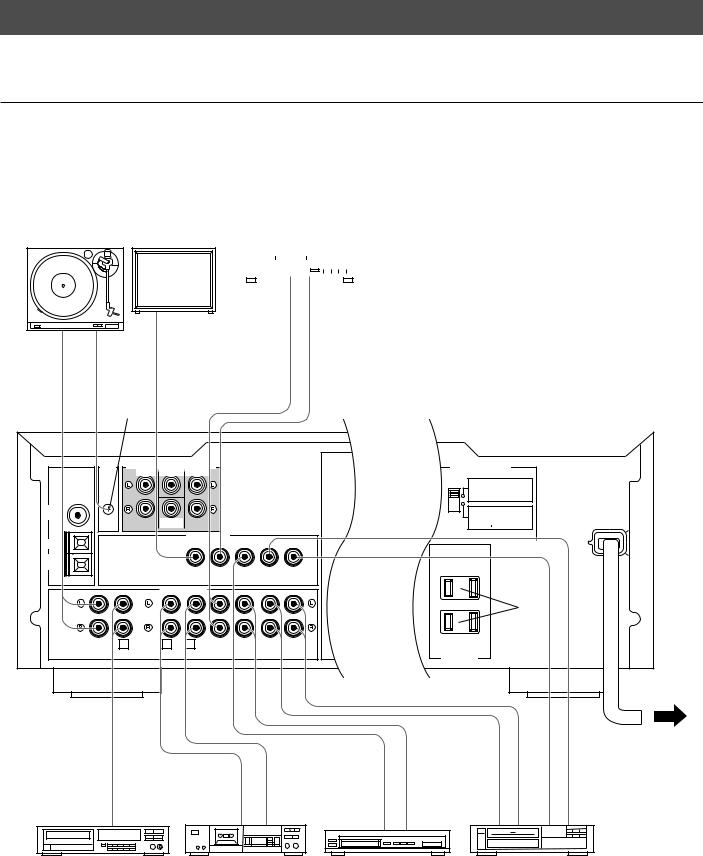
CONNECTIONS
Never plug in this unit and other components until all connections are completed.
CONNECTIONS WITH OTHER COMPONENTS
When making connections between this unit and other components, be sure all connections are made correctly, that is to say L (left) to L, R (right) to R, “+” to “+” and “–” to “–”. Also, refer to the owner’s manual for each component to be connected to this unit.
*If you have YAMAHA components numbered as 1, 2, 3, etc. on the rear panel, connections can be made easily by making sure to connect the output (or input) terminals of each component to the same-numbered terminals of this unit.
Turntable |
Monitor TV |
LD player etc. |
||||||||||||
|
|
|
|
|
|
|
|
|
|
|
|
|
|
|
|
|
|
|
|
|
|
|
|
|
|
|
|
|
|
|
|
|
|
|
|
|
|
|
|
|
|
|
|
|
OUTPUT |
GND |
|
VIDEO IN |
|
|
|
|
AUDIO OUT |
VIDEO OUT |
|
|
|
|
|
|
2 |
|
|
|
|
|
|
|
|
|
|
|
* |
|
|
|
|
|
|
|
|
(U.S.A. model) |
|
|
|
|
|
|
|
|
|
|
|
|
||
|
GND |
|
6CH DISCRETE INPUT DVD/LD TV/DBS |
|
|
|
IMPEDANCE SELECTOR |
|
||||
|
|
|
MAIN |
CENTER |
SURROUND |
|
|
|
|
|
|
|
|
|
|
|
|
|
|
|
|
|
REAR |
6ΩMIN. /SPEAKER |
|
|
75Ω UNBAL. |
|
|
|
|
|
|
|
|
CENTER |
SINGLE:6ΩMIN. /SPEAKER |
|
|
|
|
|
|
|
|
|
|
|
DUAL:3ΩMIN. /SPEAKER |
|
|
|
|
|
|
|
|
|
|
|
|
MAIN |
A OR B:4ΩMIN. /SPEAKER |
|
|
|
|
|
|
|
|
|
|
|
|
A B:8ΩMIN. /SPEAKER |
|
FM |
|
|
|
|
|
|
|
|
|
REAR |
8ΩMIN. /SPEAKER |
|
ANT |
|
|
|
|
|
|
|
|
|
CENTER |
SINGLE:8ΩMIN. /SPEAKER |
|
|
|
|
SUB |
|
|
|
|
|
|
DUAL:4ΩMIN. /SPEAKER |
MAINS |
|
|
|
|
|
|
|
|
|
|
MAIN |
A OR B:8ΩMIN. /SPEAKER |
||
|
|
|
|
WOOFER |
|
|
|
|
|
|
A B:I6ΩMIN. /SPEAKER |
|
|
|
|
|
|
VIDEO SIGNAL |
|
|
|
|
|
|
|
GND |
|
|
|
|
|
|
|
|
|
|
|
|
AM |
|
|
|
|
|
|
|
|
|
|
|
|
ANT |
|
|
|
|
MONITOR |
|
|
IN |
OUT |
|
|
|
|
|
|
|
|
DVD/LD |
TV/DBS |
|
|
|
|||
|
|
|
|
|
OUT |
VCR |
|
|
|
|
||
|
|
|
|
|
|
|
VIDEO |
|
|
|
|
|
|
|
|
|
AUDIO SIGNAL |
|
|
|
|
|
|
1 |
|
|
|
|
|
|
|
|
|
|
|
|
* |
|
|
|
|
|
TAPE |
REC |
|
|
|
|
|
|
|
|
|
|
|
|
|
|
|
SWITCHED |
|
|
||
|
|
1 |
|
3 PB |
4 OUT |
|
|
IN |
OUT |
|
|
|
|
PHONO |
|
DVD/LD |
TV/DBS |
I20V 60Hz |
|
|
|||||
|
CD |
|
TAPE ( MD ) |
VCR |
|
MAX. TOTAL |
|
|
||||
|
|
|
|
|
|
|
|
|
|
OUTLETS |
|
|
To AC outlet
OUTPUT |
LINE OUT |
LINE IN |
VIDEO OUT |
AUDIO OUT |
AUDIO OUT |
AUDIO IN |
VIDEO IN |
VIDEO OUT |
CD player |
Tape deck, |
|
TV/Satellite tuner |
Video cassette recorder |
||||
|
MD recorder, etc. |
|
|
|
|
|
|
|
*1, *2 : See the next page.
8
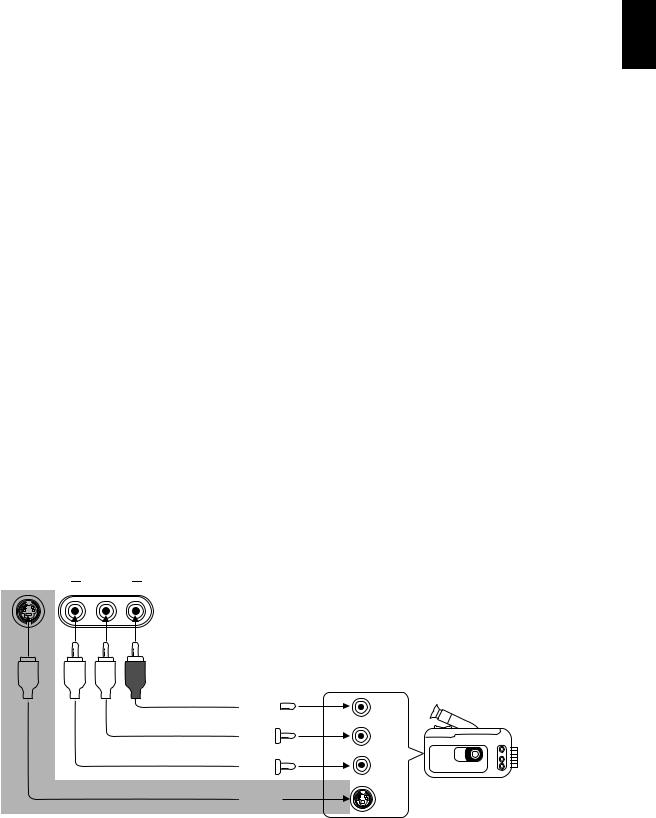
1
AC* OUTLET(S) (SWITCHED)
(U.S.A., Canada, Singapore and General models)
.......................................................... |
2 SWITCHED OUTLETS |
(Australia model) ................................. |
1 SWITCHED OUTLET |
Use these to connect the power cords from your components to this unit.
The power to the SWITCHED outlets is controlled by this unit’s POWER switch or the provided remote control transmitter’s POWER key. These outlets will supply power to any component whenever this unit is turned on.
The maximum power (total power consumption of components) that can be connected to the SWITCHED AC OUTLET(S) is 100 watts.
2
*GND terminal (For turntable use)
Connecting the ground wire of the turntable to the GND terminal will normally minimize hum, but in some cases better results may be obtained with the ground wire disconnected.
English
CONNECTING TO VIDEO AUX TERMINALS (ON THE FRONT PANEL)
These terminals are used to connect any video input source such as a camcorder to this unit.
VIDEO AUX
S VIDEO |
VIDEO |
L AUDIO R |
AUDIO OUT R  AUDIO OUT L
AUDIO OUT L 
VIDEO OUT 
S VIDEO OUT 
R
L
VIDEO
Camcorder
S VIDEO
 : S VIDEO terminal is provided for RX-V692 only.
: S VIDEO terminal is provided for RX-V692 only.
9
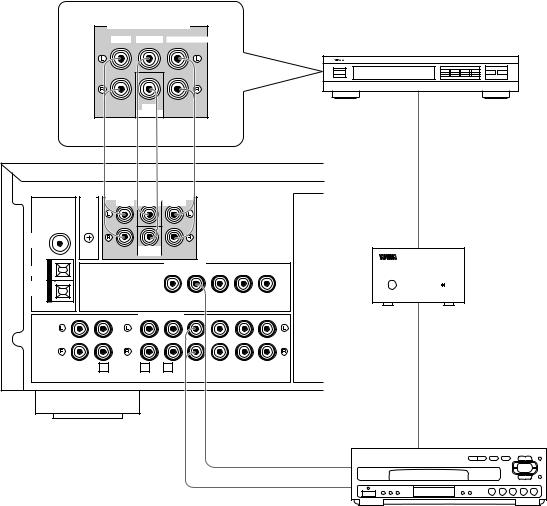
Connecting with a Dolby Digital (AC-3) Decoder
If you have a Dolby Digital (AC-3) Decoder unit or an LD player etc. which incorporates a Dolby Digital (AC-3) Decoder, its discrete outputs can be connected to this unit.
6CH DISCRETE OUTPUT
MAIN CENTER SURROUND
|
|
|
SUB |
|
|
|
|
|
|
|
WOOFER |
|
|
|
|
||
GND |
6CH DISCRETE INPUT DVD/LD TV/DBS |
|
|
|
||||
|
|
MAIN |
CENTER |
SURROUND |
|
|
|
|
75Ω UNBAL. |
|
|
|
|
|
|
|
|
FM |
|
|
|
|
|
|
|
|
ANT |
|
|
SUB |
|
|
|
|
|
|
|
|
|
|
|
|
|
|
|
|
|
WOOFER |
|
|
|
|
|
|
|
|
|
VIDEO SIGNAL |
|
|
|
|
GND |
|
|
|
|
|
|
|
|
AM |
|
|
|
|
|
|
|
|
ANT |
|
IN |
OUT |
MONITOR |
|
|
IN |
OUT |
MONITOR |
DVD/LD |
TV/DBS |
||||||
OUT |
VCR |
|
OUT |
|
VCR |
|||
|
S VIDEO |
|
|
|
VIDEO |
|
|
|
|
|
|
AUDIO SIGNAL |
|
|
|
|
|
|
1 |
|
3TAPEPB 4 OUTREC |
|
|
IN |
OUT |
|
PHONO |
CD |
|
TAPE ( MD ) |
DVD/LD |
TV/DBS |
|
VCR |
|
Dolby Digital (AC-3) Decoder unit
DIGITAL
IN
DIGITAL
OUT
RF Demodulator
AC-3 RF
IN
AC-3 RF
OUT
VIDEO OUT
AUDIO OUT
Notes
•The laserdisc player (or another unit) must be also connected to the DVD/LD (or TV/DBS) AUDIO SIGNAL input terminals of this unit for playing a source with the Dolby Pro Logic Surround decoded or in normal stereo (or monaural).
•The discrete signals input to this unit cannot be recorded by a tape deck, MD recorder or VCR. To record a source played on the laserdisc player (or another unit), it must be connected to the DVD/LD (or TV/DBS) AUDIO/VIDEO SIGNAL input terminals of this unit.
Laserdisc player with AC-3 RF output or another unit with AC-3 RF output
•If you made no connection to the SUBWOOFER input terminal of this unit or you will not use a subwoofer, you should make a setting for distributing signals at the LFE channel to the right and left MAIN output terminals on the Dolby Digital (AC-3) Decoder unit.
For details, refer to the owner’s manual for the Dolby Digital (AC-3) Decoder unit.
10
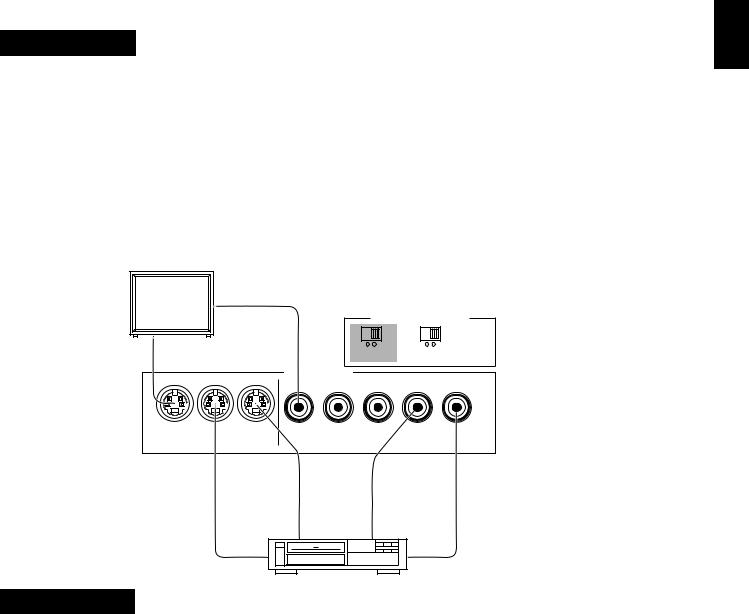
RX-V692 only
CONNECTING TO S VIDEO TERMINALS
If you have a video cassette recorder and a monitor equipped with “S” (high-resolution) video terminals, those terminals can be connected to this unit’s S VIDEO terminals. Connect the video cassette recorder’s “S” video input and output terminals to this unit’s S VIDEO VCR IN and OUT terminals respectively, and connect the monitor’s “S” video input terminal to this unit’sS VIDEO MONITOR OUT terminal. Otherwise, connect the video cassette recorder’s composite video terminals to this unit’s composite video terminals, and connect the monitor’s composite video input terminal to this unit’s composite MONITOR OUT terminal.
Note
If video signals are sent to both S VIDEO input and composite input terminals, the signals will be sent to their respective output terminals independently.
English
Monitor TV
VIDEO
IN
ON SCREEN SELECTOR
VIDEO |
IN |
|
|
|
PAL NTSC |
S VIDEO VIDEO |
||
|
|
VIDEO SIGNAL |
|
|
|
|||
|
|
|
|
|
|
|
||
S |
|
|
|
|
|
|
|
|
|
MONITOR |
IN |
OUT |
MONITOR |
DVD/LD |
TV/DBS |
IN |
OUT |
|
OUT |
|
VCR |
OUT |
|
VCR |
||
|
S VIDEO |
|
|
VIDEO |
|
|||
S VIDEO OUT |
S VIDEO IN |
VIDEO OUT |
VIDEO IN |
|
Video cassette recorder |
|
|
RX-V692 only
ON SCREEN DISPLAY
 : Provided for General model only.
: Provided for General model only.
If you connect a video cassette recorder, LD player, video monitor, etc. to this unit, you can display DSP program names and information about other settings and adjustments on the video monitor screen which is connected to the composite VIDEO (or S VIDEO) MONITOR OUT terminal of this unit. Information is superimposed over the video image.
If there is no program material on the monitor, the information will be displayed over a monochromatic background.
By using the S VIDEO/VIDEO switch, select the video monitor connected to the S VIDEO or composite VIDEO MONITOR OUT terminal on which you want to display the screen display information.
S VIDEO/VIDEO switch
S VIDEO: In this position, the screen display information is displayed on the video monitor connected to the S VIDEO MONITOR OUT terminal.
VIDEO: In this position, the screen display information is displayed on the video monitor connected to the composite VIDEO MONITOR OUT terminal.
PAL/NTSC switch (General model only)
PAL: Set to this position if your monitor TV employs the PAL format.
NTSC: Set to this position if your monitor TV employs the NTSC format.
Note
Make sure to play back a video source which employs the same format that your monitor TV employs, otherwise a picture will not be played back normally.
11
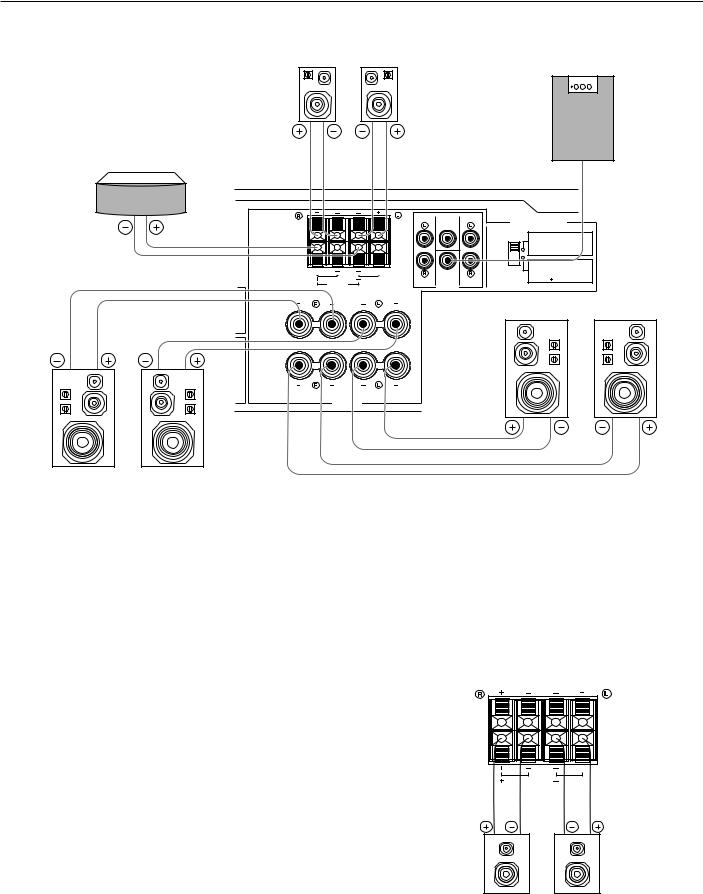
CONNECTING SPEAKERS
Rear speaker |
Rear speaker |
|
Subwoofer system |
Right |
Left |
|
Center speaker |
|
|
|
|
|
|
|
|
(U.S.A. model) |
|
||
|
|
MAIN |
CENTER |
REAR |
|
|
|
|
|
|
(SURROUND) |
IMPEDANCE SELECTOR |
|
|
REAR |
|
|
|
||
|
|
|
|
|
|
|
|
(SURROUND) |
|
|
|
REAR |
6ΩMIN. /SPEAKER |
|
|
|
|
|
||
|
|
|
|
|
CENTER |
SINGLE:6ΩMIN. /SPEAKER |
|
|
|
|
|
|
DUAL:3ΩMIN. /SPEAKER |
|
|
|
|
|
MAIN |
A OR B:4ΩMIN. /SPEAKER |
|
|
|
|
|
|
A B:8ΩMIN. /SPEAKER |
|
CENTER |
|
|
|
REAR |
8ΩMIN. /SPEAKER |
|
|
|
|
|
||
|
C |
D |
|
|
CENTER |
SINGLE:8ΩMIN. /SPEAKER |
|
|
|
|
DUAL:4ΩMIN. /SPEAKER |
||
|
DUAL |
|
SUB |
|
MAIN |
A OR B:8ΩMIN. /SPEAKER |
|
SINGLE |
|
WOOFER |
|
|
A B:I6ΩMIN. /SPEAKER |
|
|
OUTPUT |
|
|
|
|
|
CAUTION SEE INSTRUCTION MANUAL FOR CORRECT SETTING. |
|
|
|
||
|
|
|
|
|
||
|
|
|
|
Left |
Main speakers B |
|
|
A |
A |
|
|
Right |
|
Right |
B |
B |
|
|
|
|
Left |
|
|
|
|
|
|
|
MAIN |
|
|
|
|
|
|
SPEAKERS |
|
|
|
|
|
Main speakers A
Note
Use speakers with the specified impedance shown on the rear of this unit.
Note on main speaker connections:
One or two speaker systems can be connected to this unit. If you use only one speaker system, connect it to either the SPEAKERS A or B terminals.
Note on a subwoofer connection:
You may wish to add a subwoofer to reinforce low frequencies or to output low bass sound from the subwoofer channel when reproducing discrete signals.
Connect the SUBWOOFER OUTPUT terminal of this unit to the INPUT terminal of the subwoofer amplifier, and connect the speaker terminals of the subwoofer amplifier to the subwoofer. With some subwoofers, including the Yamaha Active Servo Processing Subwoofer System, the amplifier and subwoofer are in the same unit.
Note on center speaker connection:
One or two center speakers can be connected to this unit. If you cannot place the center speaker on or under the TV, it is recommended to use two center speakers and place them on both sides of the TV to orient the center sound at the center position. For connecting two center speakers, follow the method shown below.
REAR |
|
(SURROUND) |
|
CENTER |
|
C |
D |
|
DUAL |
 SINGLE
SINGLE
Center speaker |
Center speaker |
12
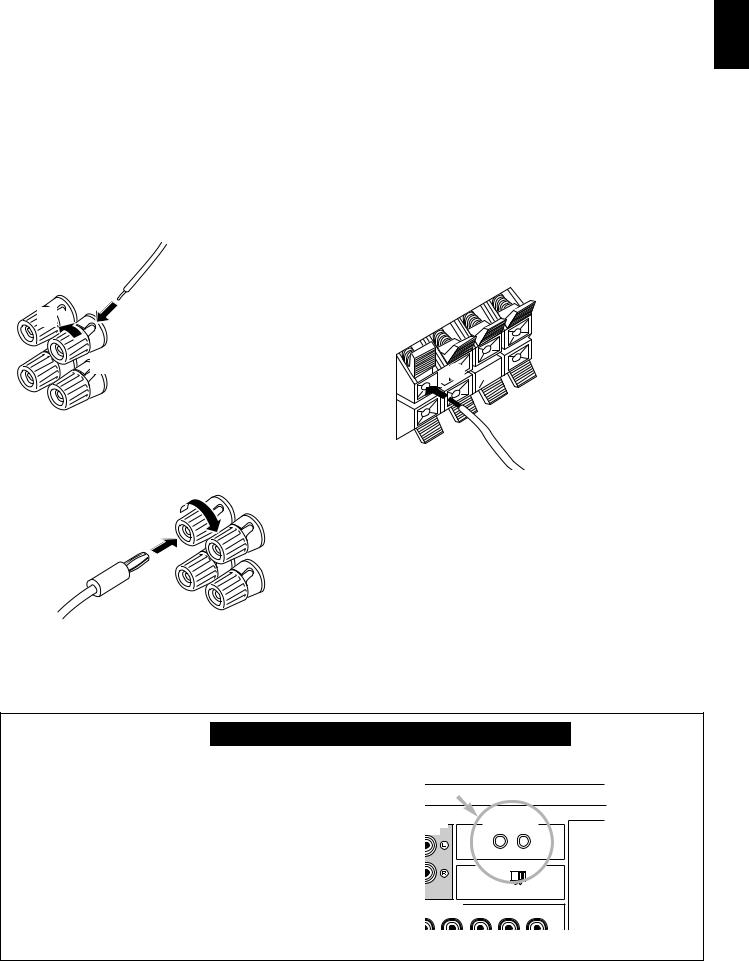
English
How to Connect:
Connect the SPEAKERS terminals to your speakers with wire of the proper gauge, cut as short as possible. If the connections are faulty, no sound will be heard from the speakers. Make sure that the polarity of the speaker wires is correct, that is the + and – markings are observed. If these wires are reversed, the sound will be unnatural and lack bass.
Caution
Do not let the bare speaker wires touch each other and do not let them touch any metal part of this unit. This could damage this unit and/or speakers.
For connecting to the MAIN SPEAKERS terminals
Red: positive (+) Black: negative (–)
2
1

 3
3
Unscrew the knob.
Insert the bare wire. [Remove approx. 5mm (1/4”) insulation from the speaker wires.]
Tighten the knob and secure the wire.
Banana Plug connections are also possible (except for Singapore model). Simply insert the Banana Plug connector into the corresponding terminal.
For connecting to the REAR and CENTER SPEAKERS terminals
Red: positive (+)
Black: negative (–)









Press the tab.
Insert the bare wire. [Remove approx. 5mm (1/4”) insulation from the speaker wires.]
Release the tab and secure the wire.
For Custom Installer For U.S.A. and Canada models of RX-V692 only
REMOTE CONTROL (IN, OUT) terminals
These terminals are used for custom installation system. When this unit is connected to the components for custom installation system, you can operate this unit with the system remote control.
Connect the REMOTE CONTROL IN terminal of this unit to the output terminal of the central controller for custom installation system.
By connecting the REMOTE CONTROL OUT terminal of this unit to the REMOTE CONTROL IN terminal of the other component, you can also operate it with the system remote control. In this way, up to 6 components can be connected in series.
UT DVD/LD TV/DBS |
REMOTE CONTROL |
||
ER SURROUND |
|
|
|
|
IN |
OUT |
|
|
ON SCREEN SELECTOR |
||
B |
S VIDEO VIDEO |
||
ER |
|||
|
|
||
VIDEO SIGNAL
13
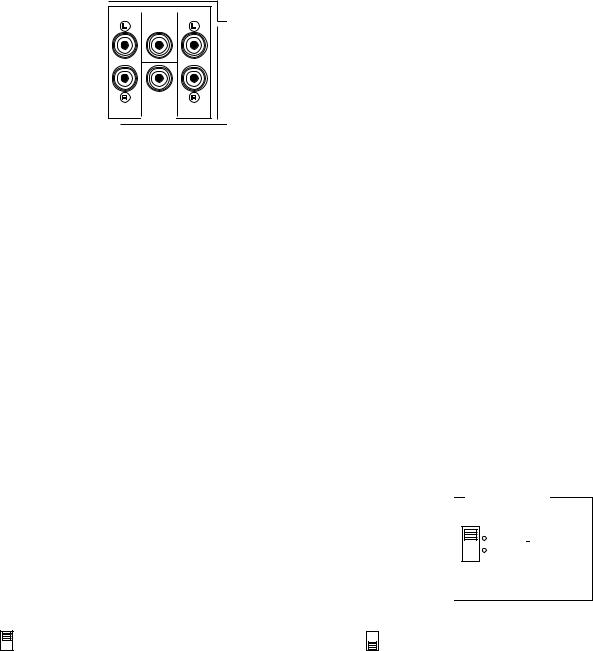
OUTPUT terminals (for driving speakers with external amplifiers)
MAIN CENTER REAR (SURROUND)
SUB
WOOFER
OUTPUT
REAR (SURROUND) OUTPUT terminals
These terminals are for rear channel line output. There is no connection to these terminals when you use the built-in amplifier.
However, if you drive rear speakers with an external stereo power amplifier, connect the input terminals of the external amplifier (MAIN IN or AUX terminals of a power amplifier or an integrated amplifier) to these terminals.
MAIN OUTPUT terminals
These terminals are for main channel line output. There is no connection to these terminals when you use the built-in amplifier.
However, if you drive main speakers with an external stereo power amplifier, connect the input terminals of the external amplifier (MAIN IN or AUX terminals of a power amplifier or an integrated amplifier) to these terminals.
*Output signals from the MAIN OUTPUT terminals only are affected by the use of BASS, TREBLE, BALANCE controls and BASS EXTENSION switch.
CENTER OUTPUT terminal
This terminal is for center channel line output. There is no connection to this terminal when you use the built-in amplifier. However, if you drive a center speaker with an external power amplifier, connect the input terminal of the external amplifier to this terminal.
SUBWOOFER OUTPUT terminal
This terminal is for connecting with the input terminal of an amplifier for driving a subwoofer.
When the input signals to this unit are in normal 2-channel stereo, this terminal outputs only frequencies below 200 Hz from the main and center channels. When discrete signals are input to this unit and are selected as the input source, this terminal outputs signals from the subwoofer channel.
Note
Output level of signals from all of these terminals are adjusted by the use of VOLUME control on the front panel or MASTER VOLUME keys on the remote control transmitter.
IMPEDANCE SELECTOR switch
Be sure to switch this only when the power of this unit is turned off.
Select the position whose requirements your speaker system meets.
(Upper position)
Rear: The impedance of each speaker must be 6Ω or higher.
Center: If you use one center speaker, the impedance of the speaker must be 6Ω or higher.
If you use two center speakers, the impedance of each speaker must be 3Ω or higher.
Main: If you use one pair of main speakers, the impedance of each speaker must be 4Ω or higher.
If you use two pairs of main speakers, the impedance of each speaker must be 8Ω or higher.
IMPEDANCE SELECTOR
|
REAR |
6ΩMIN. /SPEAKER |
|
CENTER |
SINGLE:6ΩMIN. /SPEAKER |
|
|
DUAL:3ΩMIN. /SPEAKER |
|
MAIN |
A OR B:4ΩMIN. /SPEAKER |
|
|
A B:8ΩMIN. /SPEAKER |
|
|
|
|
REAR |
8ΩMIN. /SPEAKER |
|
CENTER |
SINGLE:8ΩMIN. /SPEAKER |
|
|
DUAL:4ΩMIN. /SPEAKER |
|
|
|
|
MAIN |
A OR B:8ΩMIN. /SPEAKER |
|
|
A B:I6ΩMIN. /SPEAKER |
(U.S.A. model)
(Lower position)
Rear: The impedance of each speaker must be 8Ω or higher.
Center: If you use one center speaker, the impedance of the speaker must be 8Ω or higher.
If you use two center speakers, the impedance of each speaker must be 4Ω or higher.
Main: If you use one pair of main speakers, the impedance of each speaker must be 8Ω or higher.
<Except Canada model>
If you use two pairs of main speakers, the impedance of each speaker must be 16Ω or higher.
14
